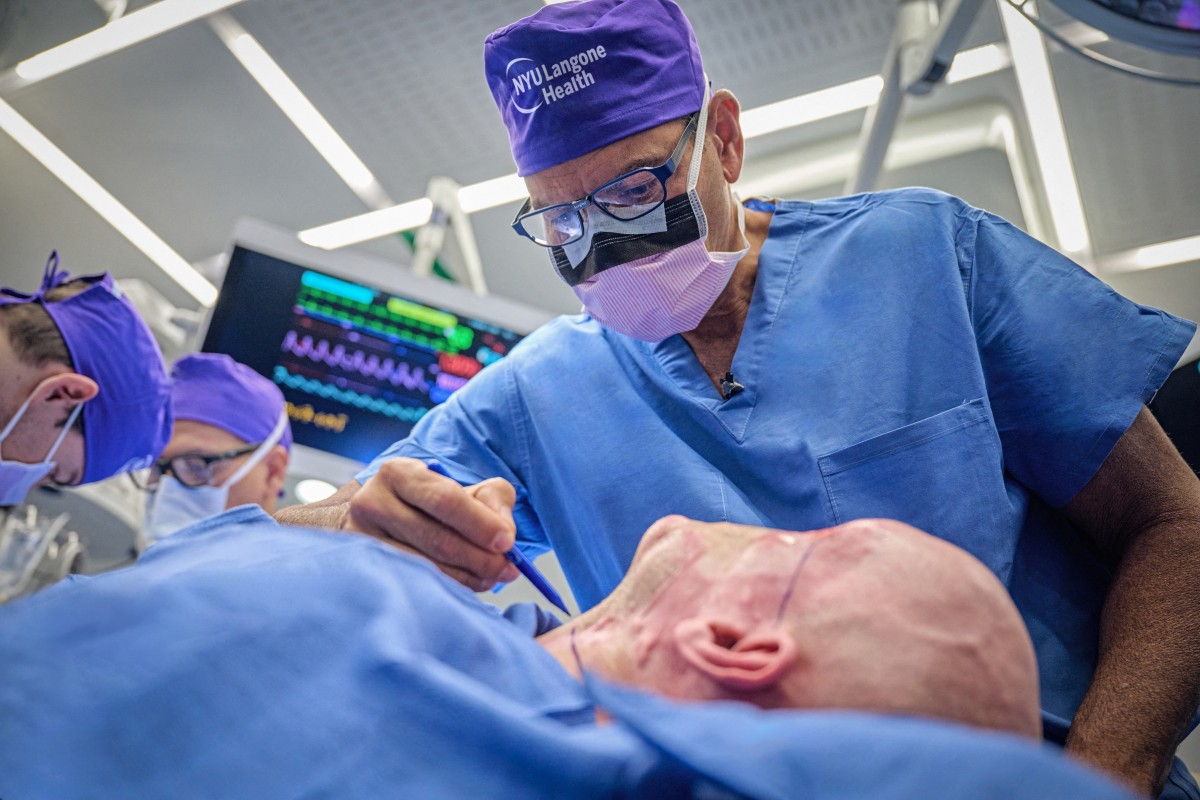A team of surgeons in New York announced Thursday they had performed the world’s first transplant of an entire eye in a procedure widely hailed as a medical breakthrough, although it isn’t yet known whether the recipient will actually regain his sight.
The groundbreaking surgery involved removing part of the face and the whole left eye of a donor and grafting them onto a line worker from Arkansas who survived a 7,200-volt electric shock in June 2021, when his face touched a live wire.
Aaron James, 46, suffered extensive injuries including the loss of his left eye, his dominant left arm above the elbow, his nose and lips, front teeth, left cheek area and chin.
He was referred to NYU Langone Health, a leading medical center for facial transplants, which carried out the procedure on May 27.
Transplanting an entire eye has long been a holy grail of medical science, and though researchers have had some success in mice — where they have restored partial vision — it’s never before been performed in a living person.
“We always talk about a second chance at life — he’s been given a second chance,” said Eduardo Rodriguez, who led the 21-hour-surgery that made use of 3D cutting guides, which allowed surgeons to remove segments of bone from the donor and place them precisely in James.
“We couldn’t have asked for a more perfect patient,” he added, praising James for undergoing the extremely risky surgery so that others in his situation could benefit in the future.
The transplanted left eye appears very healthy, said retinal opthamologist Vaidehi Dedania. It has a good blood supply, is maintaining its pressure, and is generating an electrical signal, though James is not yet able to see. “But we have a lot of hope,” she added.
– ‘Huge deal’ –
“This is a huge deal,” Kia Washington, a professor of surgery at University of Colorado Anschutz Medical Campus, who has been working in the same field for 15 years, told AFP, commending her peers.
Daniel Pelaez of the University of Miami’s Bascom Palmer Eye Institute, who has also been working towards the same goal, told AFP: “The transplantation of a human eye at NYU Langone represents a pivotal moment in our common quest to restore sight and offers hope to countless individuals around the world.”
James, whose right eye remains intact, was considered an ideal candidate because his need for a facial transplant meant he would require immunosuppressive drugs regardless, making the risk-benefit calculation favorable — even if it conferred only cosmetic value.
Appearing at a press conference, James expressed his profound gratitude to both the donor’s family and his medical team. “It’s been a test of willpower, strength, family, friends, and I think we beat it,” he said.
James returned to his native Arkansas in September to be with his wife and daughter but returns to New York for monthly follow-up appointments.
– Optic nerve regeneration –
Given the time that has passed since the surgery, Washington said she did not think it likely that James’s eye would regain vision, but “I never say something is impossible,” she added.
The NYU Langone team said they had used bone marrow-derived adult stem cells to promote nerve repair.
Achieving the goal of sight restoration could involve bringing other cutting-edge approaches to bear, said Washington — including gene therapy to tap the optic nerve’s intrinsic ability to heal; using a device called a nerve wrap to protect the tissue; or using devices that pick up signals and bypass the damaged pathway.
“We’re making great progress in the treatments to promote optic nerve regeneration that could accompany eye transplant,” Jeffrey Goldberg, who is leading similar efforts at the Byers Eye Institute at Stanford University, told AFP.
“These adjunctive therapies will allow the donor eye to significantly connect to the brain and restore meaningful visual function to blind patients everywhere.”
AFP

